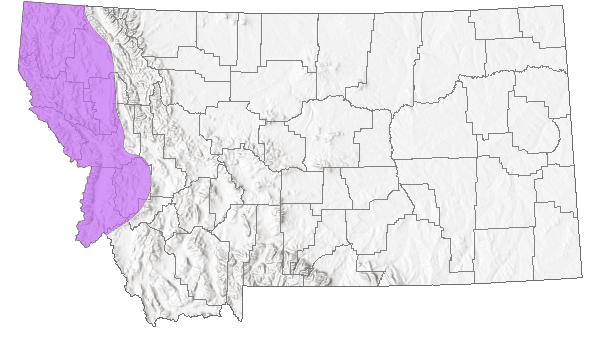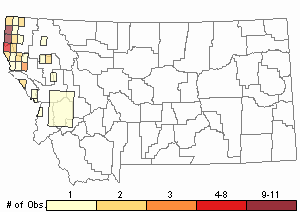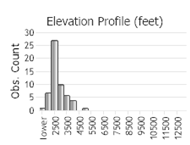View in other NatureServe Network Field Guides
NatureServe
Montana
Utah
Wyoming
Idaho
Wisconsin
British Columbia
South Carolina
Yukon
California
New York
Sheathed Slug - Zacoleus idahoensis
General Description
A small slug, animals may reach 30 mm or more, but are often smaller. The overall appearance is dark. Base color on the mantle and back is dark brown to dark purplish, with abundant bluish flecking on closer inspection, on the tail highlighting a fine pattern of reticulation. The head and tentacles appear uniformly darker than the mantle and tail on some individuals. The mantle covers less than half the length of the body. The posterior margin of the mantle is deeply notched, similar to Udosarx. The pneumostome present in the posterior half of the mantle margin on the right side, above or slightly anterior to the mantle cleft. The reticulation on the posterior half of the body (tail) is indistinct, predominately with longitudinal lines above and oblique on the sides. The back of the tail has a prominent keel especially noticeable in contracted animals. The sole is tripartite (having two longitudinal furrows); the mucous is clear (Hendricks 2012, Burke 2013). Internal anatomy is described by Pilsbry (1948). The original description was based on animals from Meadows, Adams County, Idaho.
Diagnostic Characteristics
A combination of size, coloration, mantle markings, and overall morphology readily distinguish this species from other slugs. The sole of the foot is tripartite (having two longitudinal furrows best seen when the animal crawls on a clear surface), a strongly keeled back (most prominent when the animal is more or less contracted), a small notch on the right posterior mantle margin, a pneumostome (breething pore) above or anterior to the mantle cleft. The similar lyre mantleslug slug (Udosarx lyrata) shares these traits, but Zacoleus is dark brown to dark purplish (instead of cream or bluish-gray) with abundant pale blue flecking on the tail highlighting a fine pattern of reticulation, the mantle is uniformly colored lacking any dark markings.
Species Range
Montana Range
Range Descriptions

 Native
Native
Range Comments
Northern Idaho and adjacent northwestern Montana west of the Continental Divide (Burke 2013). In Montana, 37 records in eight counties: Flathead (1), Granite (1), Lake (4), Lincoln (12), Mineral (3), Missoula (1), Ravalli (1), Sanders (14). Elevation range is 674 to 1775 m (2210 to 5725 ft). Up to 11 individuals were found at one Lincoln County, Montana site in mid-October (Hendricks 2012).
Observations in Montana Natural Heritage Program Database
Number of Observations: 63
(Click on the following maps and charts to see full sized version)
Map Help and Descriptions
Relative Density

Recency



 (Observations spanning multiple months or years are excluded from time charts)
(Observations spanning multiple months or years are excluded from time charts)
Migration
Sedentary.
Habitat
Primarily in mesic mixed conifer forest, often near water such as stream-side riparian areas and seeps, but also in more xeric sites. Canopy species include western redcedar, western hemlock, grand fir, Engelmann spruce, Douglas-fir, western larch, ponderosa pine, lodgepole pine, black cottonwood, paper birch, with a secondary canopy of alder, willow, and dogwood. Usually found under woody debris and leaf litter or in downed rotten wood, sometimes under rocks (Hendricks 2012).
Food Habits
The species is herbivorous; food includes the epiphytic cryptogam Frullania (Pilsbry 1948).
Reproductive Characteristics
The species is hermaphroditic, based on internal anatomy (Pilsbry 1948).
Stewardship Responsibility
Threats or Limiting Factors
Threats include logging and grazing over most of the known and potential ranges. The species is restricted to rather moist sites, generally in exceptionally botanically diverse and intact forests. Logging of relatively intact moderate-elevation Douglas-fir forest, grazing of much of the logged terrain, highway construction and other river right-of-way impacts, and severe forest fires all pose threats. The species has lost most of its habitat and most historic sites, according to Frest and Johannes (1995).
References
- Literature Cited AboveLegend:
 View Online Publication
View Online Publication Burke, T. E. 2013. Land snails and slugs of the Pacific Northwest. Corvallis, OR: Oregon State University Press. 344 p.
Burke, T. E. 2013. Land snails and slugs of the Pacific Northwest. Corvallis, OR: Oregon State University Press. 344 p. Frest, T.J. and E.J. Johannes. 1995. Interior Columbia Basin mollusk species of special concern. Final report to the Interior Columbia Basin Ecosystem Management Project, Walla Walla, WA. Contract #43-0E00-4-9112. 274 pp. plus appendices.
Frest, T.J. and E.J. Johannes. 1995. Interior Columbia Basin mollusk species of special concern. Final report to the Interior Columbia Basin Ecosystem Management Project, Walla Walla, WA. Contract #43-0E00-4-9112. 274 pp. plus appendices. Hendricks, P. 2012. A Guide to the Land Snails and Slugs of Montana. A report to the U.S. Forest Service - Region 1. Montana Natural Heritage Program, Helena, MT. vii + 187 pp. plus appendices.
Hendricks, P. 2012. A Guide to the Land Snails and Slugs of Montana. A report to the U.S. Forest Service - Region 1. Montana Natural Heritage Program, Helena, MT. vii + 187 pp. plus appendices. Pilsbry, H.A. 1948. Land Mollusca of North America (north of Mexico), Volume II Part 2. The Academy of Natural Sciences of Philadelphia Monograph Number 2(2): 521-1113.
Pilsbry, H.A. 1948. Land Mollusca of North America (north of Mexico), Volume II Part 2. The Academy of Natural Sciences of Philadelphia Monograph Number 2(2): 521-1113.
- Additional ReferencesLegend:
 View Online Publication
View Online Publication
Do you know of a citation we're missing? Forrester, D.J. 1960. A preliminary investigation of the protostrongylin lungworm-bighorn sheep relationships in Montana. M.S. Thesis. University of Montana, Missoula. 79 pp.
Forrester, D.J. 1960. A preliminary investigation of the protostrongylin lungworm-bighorn sheep relationships in Montana. M.S. Thesis. University of Montana, Missoula. 79 pp. Frest, T.J. and E.J. Johannes. 2001. An annotated checklist of Idaho land and freshwater mollusks. Journal of the Idaho Academy of Science 36(2):1-51.
Frest, T.J. and E.J. Johannes. 2001. An annotated checklist of Idaho land and freshwater mollusks. Journal of the Idaho Academy of Science 36(2):1-51. Hendricks, P., B.A. Maxell, and S. Lenard. 2006. Land mollusk surveys on USFS Northern Region lands. A report to the USDA Forest Service, Northern Region. Montana Natural Heritage Program, Helena, Montana. 11 pp. plus appendices.
Hendricks, P., B.A. Maxell, and S. Lenard. 2006. Land mollusk surveys on USFS Northern Region lands. A report to the USDA Forest Service, Northern Region. Montana Natural Heritage Program, Helena, Montana. 11 pp. plus appendices. Hendricks, P., B.A. Maxell, S. Lenard, and C. Currier. 2007. Land mollusk surveys on USFS Northern Region lands: 2006. A report to the USDA Forest Service, Northern Region. Montana Natural Heritage Program, Helena, Montana. 11 pp. plus appendices.
Hendricks, P., B.A. Maxell, S. Lenard, and C. Currier. 2007. Land mollusk surveys on USFS Northern Region lands: 2006. A report to the USDA Forest Service, Northern Region. Montana Natural Heritage Program, Helena, Montana. 11 pp. plus appendices. Hendricks, P., B.A. Maxell, S. Lenard, and C. Currier. 2008. Surveys and predicted distribution models for land mollusks on USFS Northern Region Lands: 2007. Report to the USDA Forest Service, Northern Region. Helena, MT: Montana Natural Heritage Program. 12 pp. + appendices.
Hendricks, P., B.A. Maxell, S. Lenard, and C. Currier. 2008. Surveys and predicted distribution models for land mollusks on USFS Northern Region Lands: 2007. Report to the USDA Forest Service, Northern Region. Helena, MT: Montana Natural Heritage Program. 12 pp. + appendices. Pilsbry, H.A. 1939. Land Mollusca of North America (North of Mexico), Volume 1, Part 1. Monograph of the Academy of Natural Sciences of Philadelphia Monograph Number 3 (1): 1-573.
Pilsbry, H.A. 1939. Land Mollusca of North America (North of Mexico), Volume 1, Part 1. Monograph of the Academy of Natural Sciences of Philadelphia Monograph Number 3 (1): 1-573. Smith, A.G. 1943. Mollusks of the Clearwater Mountains, Idaho. Proceedings of the California Academy of Sciences, fourth series, 23:537-554.
Smith, A.G. 1943. Mollusks of the Clearwater Mountains, Idaho. Proceedings of the California Academy of Sciences, fourth series, 23:537-554.
- Web Search Engines for Articles on "Sheathed Slug"
- Additional Sources of Information Related to "Snails / Slugs"





